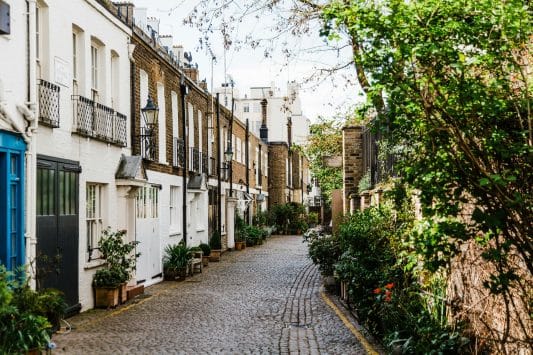

McLoughlin Planning is pleased to have helped a property owner secure Permission in Principle (PiP) with the London Borough of Sutton for an upward extension (airspace) development for 9 new flats. This is the first approved Permission in Principle granted by this London Borough.
Due to the significant number of reports and plans required through validation for full planning permissions, we have been approached by SME developers to find a means of managing development risk and to ensure the principle of their aspirations is something which can be agreed with the Council before investing in the technical work required. This is particularly applicable to constrained inner-city urban development sites where upward extensions for airspace development can be met with resistance.
Following previous success in London in using Permission in Principle, we worked with the landowner to develop a scheme which could be presented through a PiP to secure the principle of airspace development for the property. As this application type considers only the location, land use and amount of development, the level of supporting information is a fraction of a full planning permission. Whilst it does not remove the considerations and risks of subsequent technical considerations, it does provide an opportunity to agree with the Council whether the amount (i.e. number of residential flats) and location of the airspace development is acceptable. As PiP’s are limited to up to 9 residential units, this type of proposal is ideally suited for smaller development proposals in urban areas.
Following submission, McLoughlin Planning worked closely with the Council and case officer to ensure the proposal was being determined correctly and to agree with the officer on the appropriate amount of development which would be realistic to approve for further technical consent.
We are so pleased to have helped provide the landowner with reassurance through the PiP of their property’s development potential and to secure another first with a London Borough.
 If you would like a FREE initial consultation call to explore whether your property could benefit from PiP, then please get in touch!
If you would like a FREE initial consultation call to explore whether your property could benefit from PiP, then please get in touch!

We are delighted that following our involvement, planning permission has been secured for a garage conversion to enlarge the habitable living space of a mews house in the Royal Borough of Kensington and Chelsea (RBKC), despite a historic refusal on site for a similar scheme. The result of our recent planning approval will be the creation of a more spacious family home in a central and sustainable location, whilst also future proofing the building through important renovation works.
When a second opinion counts in planning
Our team was initially approached to assist following a planning refusal by RBKC for a similar scheme. The key concerns raised by the Local Planning Authority (LPA) related to:
As the property was centrally located in London, existing data advised us that surrounding streets were already heavily subscribed with parking permits and therefore could not afford the additional pressures. Furthermore, whilst garage conversions can, in some instances, be undertaken without the need for planning permission, a historic planning condition on the Mews property prevented the occupiers from benefiting from this opportunity.
Following a detailed review of the project, the previous refusal, the site’s context, and the relevant policies in the new Local Plan, we felt that there would be merit in revisiting the scheme and prepared a planning strategy for moving the project forward.
Turning a planning refusal into an approval – collaboration is key
Given the sensitive nature of the site, we worked closely with the team at Haine & Co Architects, to ensure that the revised design responded to the concerns raised in the previous planning refusal. The updated design sought to create a development which would be architecturally sympathetic to the age and character of the host building- reinforcing the original integrity of the site and its environs which was praised in the Officer’s Report. Furthermore, the additional space at the property would allow for a more comfortable living space and would make best use of the existing footprint.
Regarding the parking issues, we prepared and presented a case to the LPA that a Section 106 legal agreement could be used to make the development “car-free”, given the site’s highly sustainable location. This would assuage concerns over additional pressures to on-street parking in the vicinity.
Following submission of the application, we liaised regularly with the case officer, ensuring they had everything they needed to make a timely determination. Upon completion of the legal agreement, the Council acknowledged that the previous reasons for refusal had been overcome and that Planning Permission could now be granted.
The importance of a strategic planning approach
The above case is a useful reminder that a planning refusal does not necessarily mean that your development aspirations must come to a halt. Indeed, a refusal can help your proposals evolve, especially when combined with a strategic planning approach.
If you have recently had a planning refusal and would like a member of our team to review your case and explore whether there is a way forward to secure planning approval for your project, then please contact us through either our “Arrange a Call” tab on our contact page or via the email and telephone number provided below:
Chris Moore – Director
T: 01242895008
E: chris.moore@mplanning.co.uk

We are delighted that following our involvement, planning permission has been secured for the erection of six new apartments in the heart of Cinderford.
It was an interesting site, located within the development boundary of Cinderford and previously associated with commercial uses. But it was also an irregular shape, bounded by commercial and residential units, and had a recent planning refusal for a similar scheme on site.
It seemed to be heading in a similar direction again as, prior to our involvement in the project, the applicant had received negative feedback from the planning officer on the latest application. Fearing a planning refusal and not sure how to most effectively respond to the comments received, we were approached and asked by the applicant to review the case officer’s commentary to date, provide guidance on how best to amend the scheme and to prepare supporting evidence/mitigation measures to help navigate the proposals to a positive outcome.
Given the complexities of the space, key planning considerations included:
We provided the project team with a critical analysis of both the planning policy requirements and the feedback from the officer and weighed this against the proposed development. Our input helped to ensure that the redesign met the technical requirements set out in both local and national policy documents.
It was great to be working on the scheme with Edge Design Workshop. Their considered revisions to the scheme included: removal of a disused MEB building to unlock more of the site; clever design of the housing units to ensure space standards and amenity space requirements were amply met; suitable parking provision for both existing and future residents; design amends to remove the risk of overlooking.
Alongside our advice to the architect, the applicant also commissioned us to write a planning statement, clearly highlighting the previous concerns from the case officer and how these have been addressed in the revised proposal.
The Council remained co-operative throughout the process and ensured a fair assessment of the Site and the revisions undertaken. The result was a positive conclusion, unlocking a valuable brownfield site for the delivery of much needed new homes in Cinderford.
We are so pleased with the outcome, and that through our careful analysis of planning policy and context, effective engagement with the project team and the presentation of a clear and considered planning strategy – this dilapidated site will now be regenerated to the benefit of the local area and will bring new, stylish apartments to a central and sustainable location.
If you have a brownfield site, are wondering about its development potential and would like a member of our team to review your case and explore whether there is a way forward to secure planning approval for your project, then please contact us through either our “Arrange a Call” tab on our contact page or via the email and telephone number provided below:
Chris Moore – Director
T: 01242895008
E: chris.moore@mplanning.co.uk
Image source: Edge Design Workshop (2024)

McLoughlin Planning has secured planning approval for 13x affordable homes with associated works on land to the north of Down Ampney, near Cirencester at Planning Committee. The proposed development will deliver much-needed housing on an allocated parcel of land within the Cotswold District Council Local Plan and inside a defined settlement boundary. The approved scheme is a high-quality, considered and sensitively designed residential development which strives to set a “new standard” for the delivery of affordable housing. These homes will be among the most energy efficient to be built in the district in recent years, in accordance with the Government and Council’s climate action ambitions.
The proposed development will provide 100% affordable housing in an area where there is high demand. The housing mix directly responds to an identified need for the provision of smaller family homes in the area and, as a result, a mix of 2x and 3x bedroom homes will be developed.
The project team worked rigorously through technical analysis and feedback from community engagement exercises, to ensure that the final scheme successfully responded to existing site constraints and opportunities. In addition, the development seeks to set a “new standard” for the delivery of affordable housing, with a fabric-first approach to ensure the project meets its target of being highly sustainable.
The scheme will also provide the following benefits:
Furthermore, the site itself was once used for garaging and car parking but is now overgrown and fenced off from public use. These proposals will enable the sustainable use of a redundant site, in a location that is within the development boundary.
This policy compliant scheme in a sustainable location will deliver on the Local Plan’s development allocation and provide much-needed new affordable housing in Down Ampney. The aspiration is to set a new standard of build quality for affordable housing, with the development seeking to provide holistic renewable energy solutions to support low energy costs. This visionary development builds on a collaboration agreement between Bromford and Cotswold District Council to facilitate the development of sustainable, affordable homes in the area.
It was great to work with Bromford Housing Association on this project, with excellent architectural vision from Ridge and Partners Architects and landscape and ecological input from EDP. We thank Cotswold District Council, its elected members, and consultees for their thoughtful response to this considered, needed, and well-designed affordable housing scheme which has community at its heart.
We are McLoughlin Planning, and our team has a simple objective: to get results for our clients by providing high quality planning consultancy.
Our team of chartered town planning consultants deal with a host of interesting planning projects from across southern England and Wales – from strategic promotions and commercial premises to private developments and rural projects.
We are a friendly and approachable team who care passionately about the built environment, always striving to get the best outcome for our clients and the community.
If you have a development project which would benefit from expert planning consultancy input, then feel free to contact us through either our “Arrange a Call” tab on our contact page or via the email and telephone number provided below.
Chris Moore – Director
E: chris.moore@mplanning.co.uk
T: 01242 895008
Project Team:
Image Source: Ridge and Partners (2024)
We have a simple objective: to get results for our clients by providing high quality planning consultancy. That means our goal is to secure planning permission or an allocation for development.
We have used McLoughlin Planning (London) on two or three occasions and found them efficient, knowledgeable and excellent at negotiating with Local Authorities and third parties. Their concise and specific advice helped us win approval for schemes which had previously been notified for refusal. We would not hesitate using them again for planning issues in London.
Rob Haine Haine & Co. Ltd.Having worked with Nathan and his team for a number of years, I have found he offers a rare combination of intellectual rigour and practical focus, coupled with a commercial approach. He is solution orientated and capable of delivering on accelerated timelines for clients at the highest level with exacting standards and positive results.
Craig Jordan Jordan HennessyI have known Nathan for over 10 years and have used his services to great effect where professionalism, tenacity and a clear focus have been required, to deliver successful results. With a cool head, aligned with attention to detail and commercial acumen, he and his team work effectively and diligently and we look forward to engaging on other projects in the future
Grant Westall-Reece AvantWorking with McLoughlin Planning has been very enjoyable. I have always found the team knowledgeable and easy to work with. They have always been professional and have managed to achieve the results desired.
Matt Richardson Legal and General HomesWe have used Nathan and his team to help with a range of planning matters on a number of occasions. I have always found them to be extremely helpful, responsive and proactive. Nathan always makes himself available for phone calls and or meetings. He is especially patient and good at explaining complex matters in a very user friendly way.
Mark Lawson The Buying SolutionWe have worked with McLoughlin Planning for many years and have always been very pleased with level of service in helping us navigate the ever-changing planning system. I also never cease to be impressed by the answers to the completely random questions I ask Nathan about possible new sites, normally in several different locations at one go.
Ian Hitchings Partridge Homes (Cotswolds) LtdAfter many years of working with Nathan and his team, we know we can trust their planning opinion. They often provide a solution that demonstrates Planning experience and expertise and the benefit of their input is measured by the planning approval success and infrequent need to go to appeal on a decision.
George Paton WebbPatonWe have consistently used McLoughlin Planning to successfully promote greenfield development sites in a variety of locations. Aside from their technical capabilities, we also value their considered approach to projects - particularly when dealing with delicate and complex planning issues. This makes them a natural part of our team.
Alistair Watson Welbeck Strategic LandIf you are interested in finding out how we can help you please get in touch
Notifications